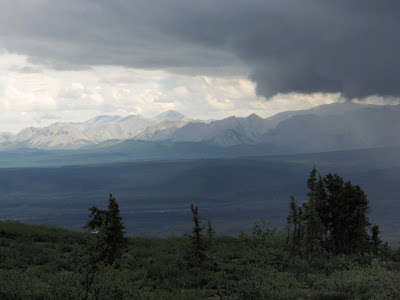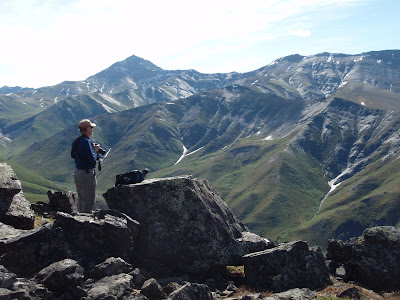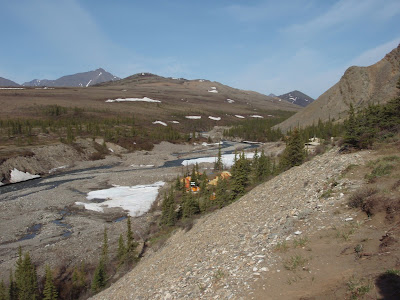June 24, Dawson City again,
We made it! Drove
the Dempster all the way to Inuvik and back and lived to tell the tale. There were some challenges for sure, but all
in all, the rewards were worth the effort.
Inuvik is a great place to visit – a world away from our southern
experience of Canada. Although its single
tenuous connection by road to the rest of us is south to Dawson City and
Whitehorse, its focus is clearly north.
The delta, the sea, the rest of the arctic is very much the direction
they face.
It’s the first northern town I’ve seen with the curiously
visible infrastructure called ‘utilidors’.
Snaking along behind every row of homes or businesses is a continuous
elevated boxlike train containing water and sewer pipes. Every building has a branch that heads off
across the back yard to connect to the town services. There’s no running through the back lanes
here unless you can leap tall utilidors in a single bound. (Apparently they used to be flat roofed
wooden structures which did make running from house to house more fun in the
olden days!) The reason of course is the
underlying permafrost which prevents virtually any below ground
development. All buildings sit on stilts
with a three to four foot air space to prevent thawing and the resultant
sinking. It does mean you can build a
great root cellar.
For a town of 3500 people, it’s surprisingly well
serviced. There’s a beautiful library,
new schools, college, fitness centre, hockey and curling rinks, ski trails, and
a wonderful Hawaiian themed indoor pool.
The liquor store is massive, which unfortunately reflects one of the
problems common to much of the north.
The grocery stores are well supplied but horrifyingly expensive. We splurged on a bag of fresh cherries for
$16 and stocked up on fresh milk at $3.59 a litre. (Almost as bad was the diesel at $1.89 per
litre.) But we did find bargain priced
reindeer steaks by calling a number we were given, finding the guy’s home, and
digging through six freezers in his ramshackle yard. (Twelve hundred reindeer, a cousin of the
native caribou, were herded here from Alaska many years ago and now about 4000
roam freely, managed locally for meat.)
Our favourite stop in Inuvik was the community
greenhouse. Converted from an old ice
rink, it now houses dozens of raised beds, already bursting with edible greens,
herbs, rhubarb, flowers and budding tomatoes, peppers, eggplants and
squash. It’s been a huge contribution to
food security here, where 57 days of continuous sun provides only the briefest
of growing seasons between the colder months.
The seasons here are either endless (winter, I imagine),
brief (summer and fall), or nonexistent (spring). When we drove up the Dempster 2 weeks ago the
willows and aspens were barely budding, there was ice on many lakes and streams,
and it was frosty at night. Now the
shrubs and few deciduous trees are fully leafed out, snow only clings to the
north facing slopes, and it’s 30 degrees today.
And mosquito season is in full swing!
The locals say it’s a bad year, but I think Manitoba still has the lead
in Canadian insect culture. We had to
cover up along some of the rivers when we were fishing or hiking, but above the
tree line or in any breeze we weren’t troubled.
Fishing – I’d have to say poor, although Norbert did
catch a nice big arctic grayling for the pan, and several smaller ones. Hiking – spectacular, especially in Tombstone
Territorial Park, just 60 km north of Dawson.
I said we’d had some challenges, and one of them was a steep, slippery,
rooty, rocky, sweaty climb up through heavy brush to a lookout. Once there, panting and exhausted, I was just
beginning to appreciate the effort when a humungous thunderstorm swept in and
sent us hurtling down the now more slippery path to shelter as the lightning
cracked around us. Great hike! Luckily it was balanced by a stupendous hike
above the tree line next day – no bears, no bugs, no storms, and endless
views. I’m afraid this is where my
inadequacy as a photographer is really evident – the magnificence of these
mountain vistas is just impossible to reproduce. Norbert is a much better photographer, but he
keeps all his photos on his camera so we won’t have the benefit of his gift til
much later.
And I mustn’t forget the difficulties of driving 743 km
of rather dodgy gravel. The Dempster
shredded two of our tires on the return trip.
The first, a sudden flat, occurred 120 km from nowhere, and we managed
to fix it with the help of some other travelers who stopped to assist. (We had practiced this maneuver just in case
– the road does have a reputation for eating tires.) The second we noticed while we were working
on number one. One of our front tires
was bulging ominously on one side, and we’d just used our only spare. We limped in to Eagle Plains the next day at
20 km per hour, hobbling along on our egg shaped tire which had lost some of
its steel belting. I had visions of
spending several nights in this dusty gas station waiting for new tires from
Whitehorse, but unbelievably, there were two tires for us in stock, they were
installed while we had lunch, and we were on our way again! Great outcome!
Today we are back in Dawson City, luxuriating in clean
showers, laundry, and the usual housekeeping chores. We still have plenty of touristy things to
see here, and are waiting for another two tire replacements tomorrow, just in
case! We’ll leave here heading west,
across the Top of the World Highway into Alaska, and then on to Fairbanks,
Denali National Park, and Anchorage.
We’ll keep you posted on the next stage of the saga!
Posted June 25 at Gold Rush Campground, Dawson City
PS - Yet another tire change yesterday! Becoming experts by now, but it's still a difficult job! June 26
 |
| The RC church in Inuvik is an igloo! |
 |
| Utilidors running through the yards behind every building. I think the bright colours are to help in the long winters! Not much opportunity for outdoor gardening here. |
 |
| Inside the community greenhouse. Everyone has decorated their plot and each is a work of art. |
 |
| The tiny village of Tsiigehtchik at the confluence of the Mackenzie and Arctic Red River. Pop. 159, all First Nations except one Jamaican. Weird. |
 |
| Storm over the Dempster. The weather is stark and changes with no notice. Dress in layers really means something here - it goes from 5 to 30 in a few hours, then back again as the wind whips up. |
 |
| The peak on same hike - 360 degree views, amazing scenery. All this only two hours from the campsite! |






























